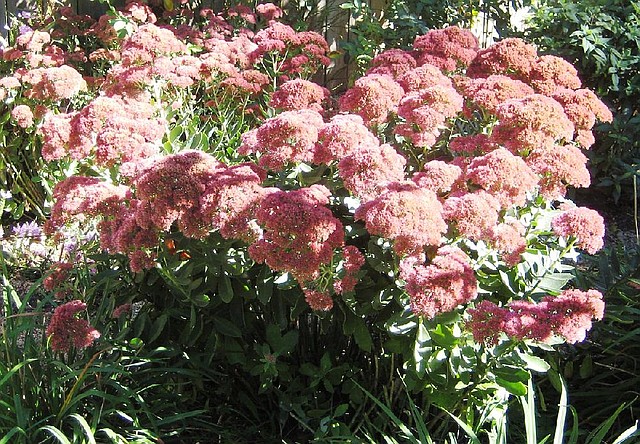IN THE GARDEN
Special to the Democrat-Gazette/JANET B. CARSON "Autumn Joy" sedum is a tall growing sedum and winter hardy in Arkansas.
Saturday, August 30, 2014
Q I have three miniature gardenia bushes that are blooming for the second time. I have been around gardenias all my life and have never known gardenias to bloom twice. We have had these shrubs for about five years, and they have never done this before. Do you suppose the weird weather we have been having has caused this? Or is it that there are some varieties of miniature gardenias that bloom twice?
A It is actually not unusual for miniatures to rebloom. I was at Garvan Gardens in Hot Springs recently and theirs were also reblooming -- but they usually do. For the more common old-fashioned larger varieties one set of flowers is typical. Many of the new varieties like "Frost Proof" and "Jubilation" are supposed to rebloom, as does the older "August Beauty" variety. They usually don't bloom as prolifically in the second round as they do in late June and early July, but this year, many gardeners may be seeing more late blooms, since some plants had winter damage and did not bloom as well early on. I also think the milder summer allowed many plants to set flower buds early for next season, so I would not be surprised to see some errant blooms on forsythia, tulip magnolias and other spring-blooming plants later this summer or early fall.
Q I have a camellia bush (tree) that reaches past the eaves of our home. When and how much do I prune it?
A Prune your camellia in the spring, after winter weather is over and your plant has finished flowering. When to expect flowers depends on which type you grow. Some bloom fall through early winter and others in late winter/early spring. If you look at your camellia now, you will notice the flower buds for this winter's display are set. From what I have been seeing in mine and in others' gardens, it is going to be a spectacular year for them. Normally we say to prune spring-blooming plants immediately after bloom, but since many camellias finish blooming when it is still cold, wait until all chances of frost have passed before pruning. But do try to get it done before they really kick in and start growing. You don't want to remove more than a third of the plant in any one year; but if you need to take off more next spring, they will recover if you prune them early enough in the season. Don't forget to water and lightly fertilize after you prune.
Q I have several night-blooming jasmine plants that are about 5 years old. The first year was great, but after that, nothing. I have them in pots and trim them back in the fall and bring them in during the winter. What am I doing wrong that they no longer bloom?
A I love night-blooming jasmine and wish I had moved mine inside to prevent it from dying for the winter. How much light does yours receive? If it is growing in too much shade, it will not flower. I would also repot them next spring when you move them back out. If they are root-bound and not growing well, they will not flower as well.
Q Can you please tell me what this plant is? It has thick fleshy leaves and is just beginning to bloom. I would like to buy some more, but I don't know what to ask for.
A The plant in question is a variety of Sedum spectabilis -- possibly "Autumn Joy," although there are many others available. This is one of the taller varieties of sedums that is winter hardy in Arkansas. Many other varieties hug the ground, but all are succulents and thrive in poor sites with dry conditions. In fact, some of the "Autumn Joy" varieties are a bit leggy and floppy this season due to the amount of rainfall we have received.
DEAR READERS: The Arkansas Vascular Flora Committee recently released a new book: the Atlas of the Vascular Plants of Arkansas. The 709-page atlas documents 2,892 plants. Each species is presented with a county-level distribution map showing where the plant has been found in the state. It is not a picture book of plants but a reference book to know where the plants can be found in the state. For more information and to buy a book, go to naturalheritage.com and look under "News & Events" for a link.
Janet B. Carson is a horticulture specialist for the University of Arkansas Cooperative Extension Service. Write to her at 2301 S. University Ave., Little Rock, Ark. 72204 or email her at
HomeStyle on 08/30/2014
